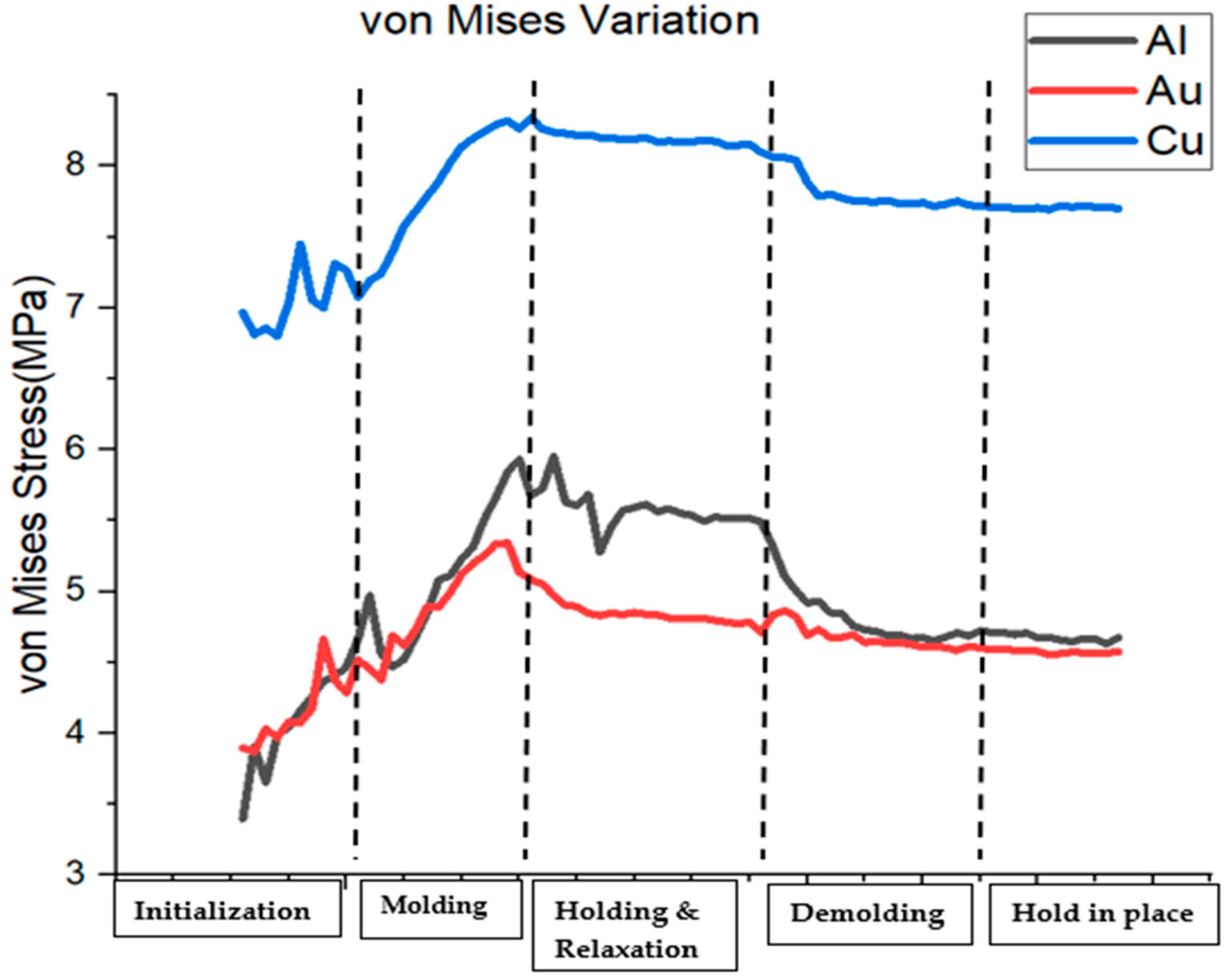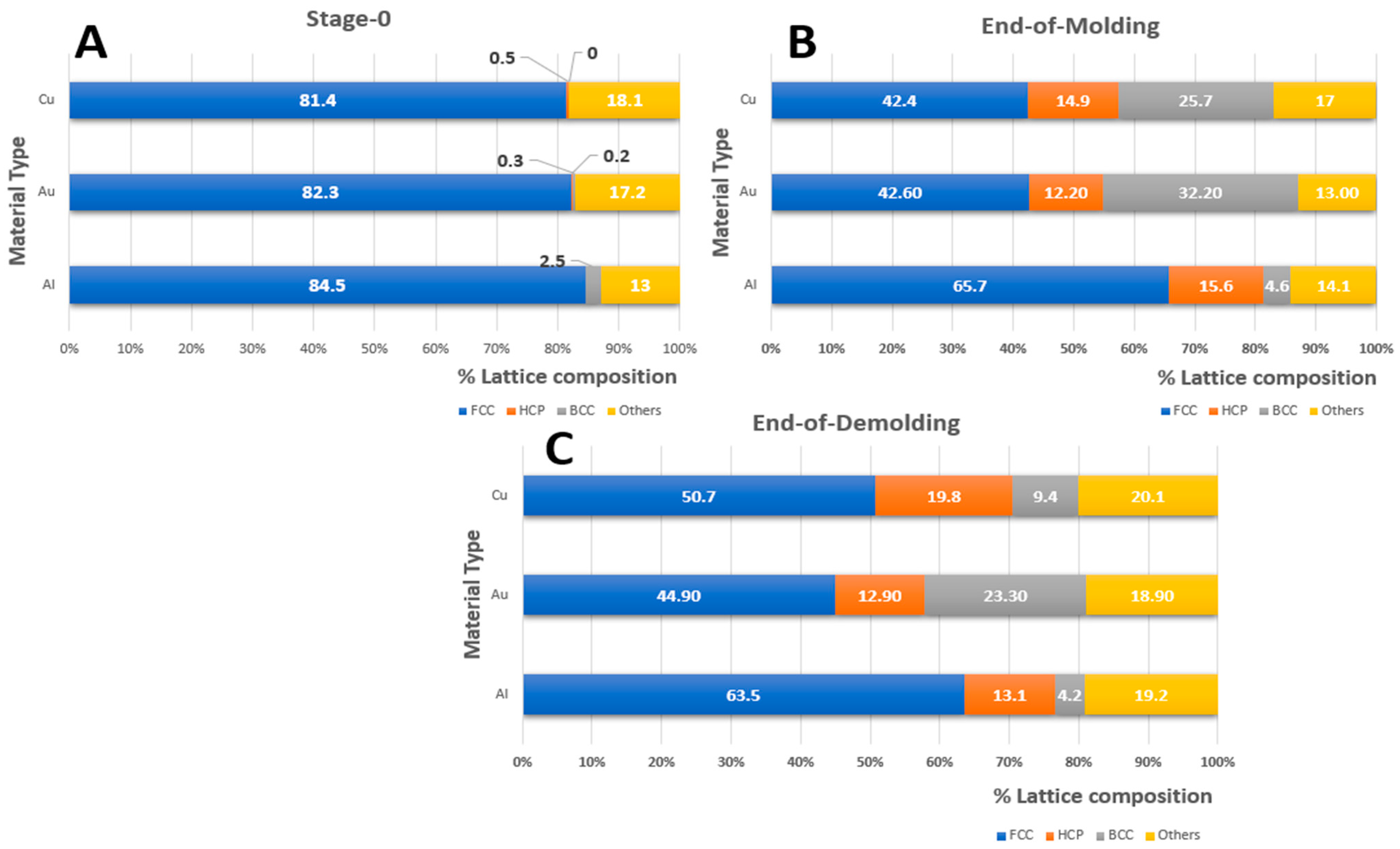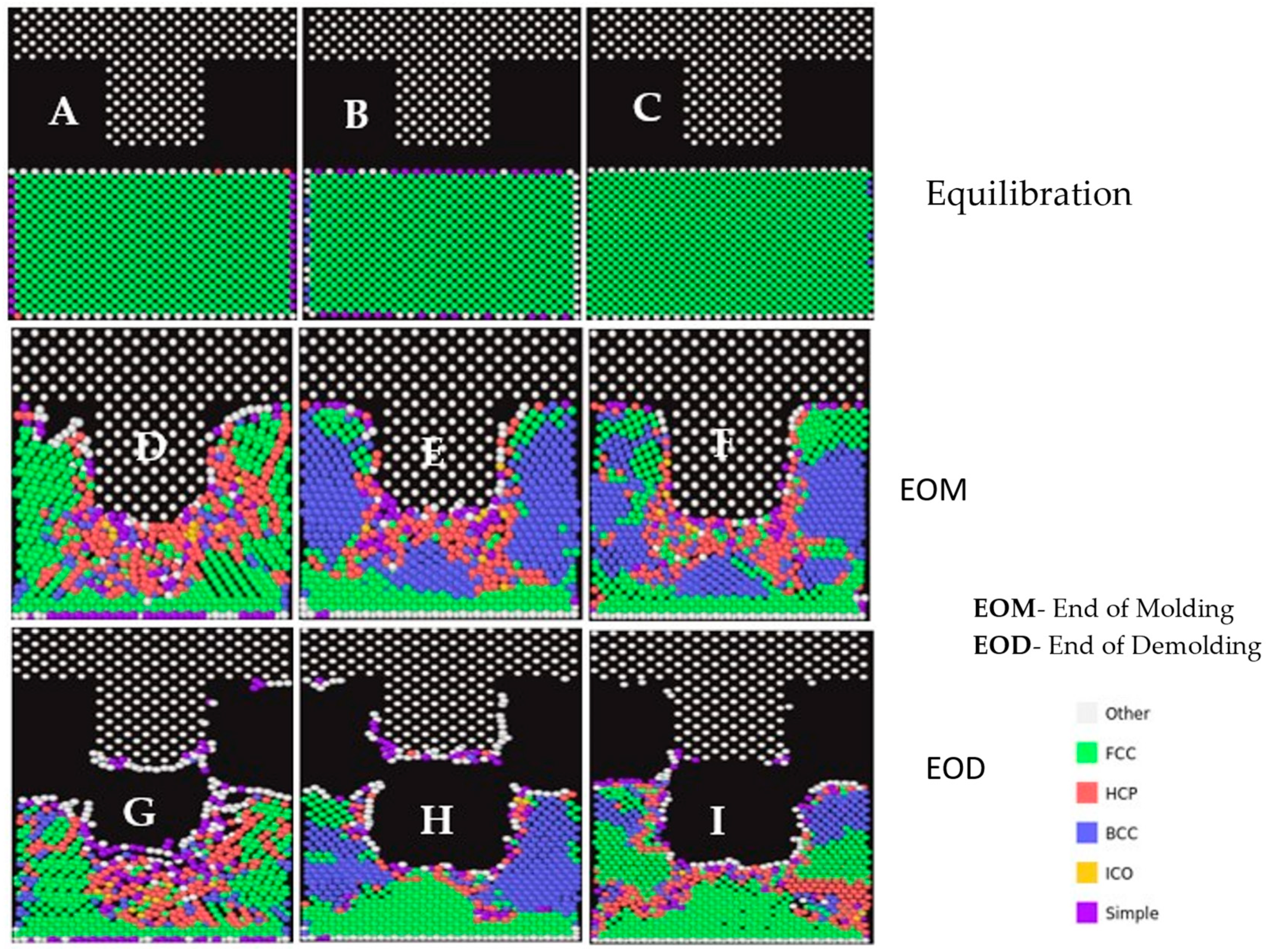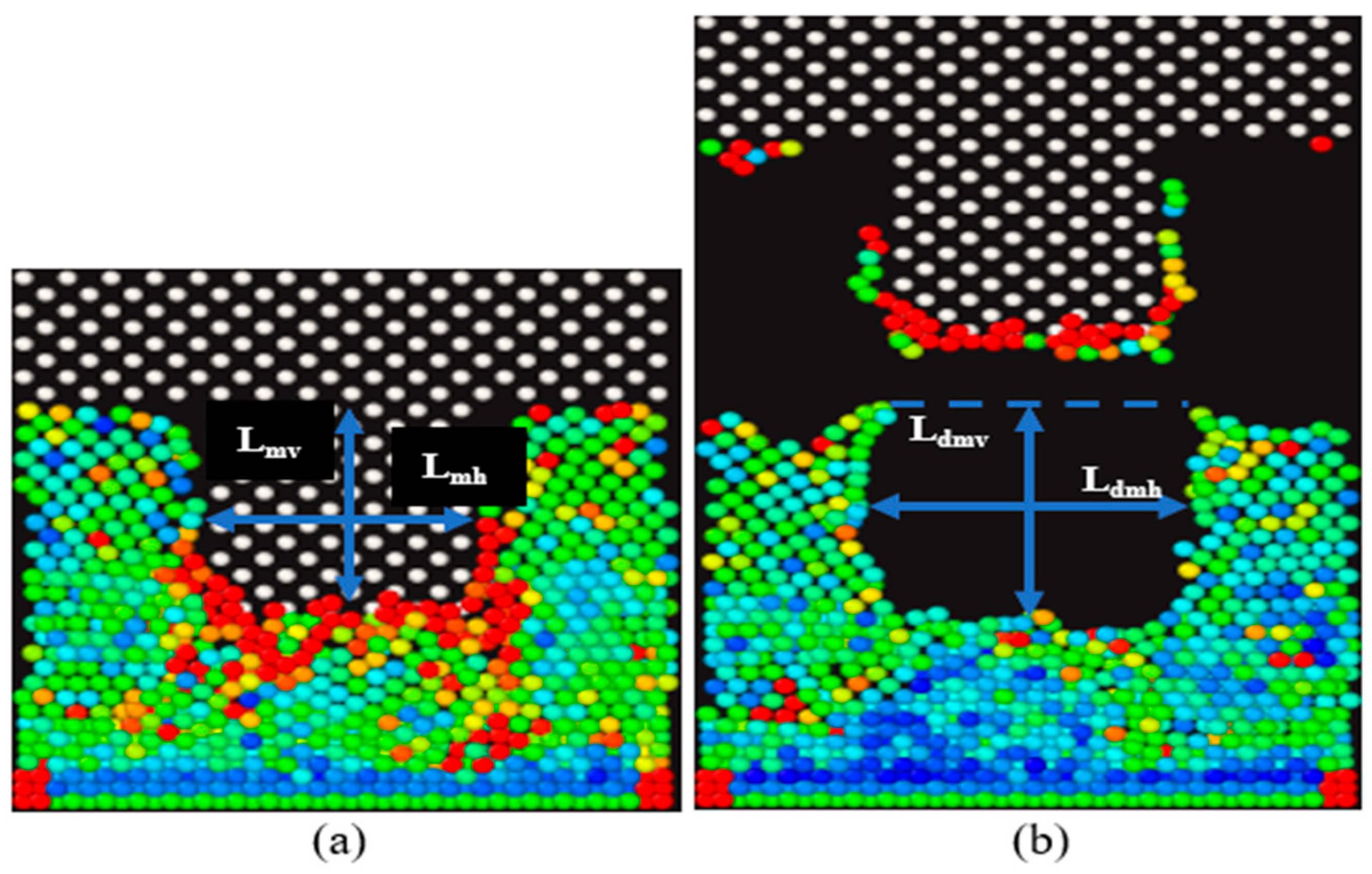Deformation Mechanism of Aluminum, Copper, and Gold in Nanoimprint Lithography Using Molecular Dynamics Simulation
Abstract
:1. Introduction
2. Materials and Methods
3. Results and Discussions
3.1. Variation in Von Mises Stress during the NIL Process
3.2. Influence of Dislocation Phenomenon on the Deformation
3.3. Deformation Behavior of Materials
3.4. Spring-Back Phenomenon
4. Conclusions
Author Contributions
Funding
Data Availability Statement
Conflicts of Interest
References
- Chou, S.Y.; Krauss, P.R.; Renstrom, P.J. Nanoimprint lithography. J. Vac. Sci. Technol. B 1996, 14, 4129–4133. [Google Scholar] [CrossRef]
- Schift, H.; Kristensen, A. Nanoimprint Lithography. In Springer Handbook of Nanotechnology; Springer: Berlin/Heidelberg, Germany, 2017; pp. 113–142. [Google Scholar] [CrossRef]
- Lan, H.; Liu, H. UV-nanoimprint lithography: Structure, materials and fabrication of flexible molds. J. Nanosci. Nanotechnol. 2013, 13, 3145–3172. [Google Scholar] [CrossRef] [PubMed]
- Schift, H.; Kristensen, A. Nanoimprint Lithography—Patterning of Resists Using Molding. In Springer Handbook of Nanotechnology; Springer: Berlin/Heidelberg, Germany, 2010; pp. 271–312. [Google Scholar] [CrossRef]
- Pease, R.F.; Chou, S.Y. Lithography and other patterning techniques for future electronics. Proc. IEEE 2008, 96, 248–270. [Google Scholar] [CrossRef]
- Chou, S.Y.; Krauss, P.R. Imprint lithography with sub-10 nm feature size and high throughput. Microelectron. Eng. 1997, 35, 237–240. [Google Scholar] [CrossRef]
- Torres, C.S.; Zankovych, S.; Seekamp, J.; Kam, A.P.; Cedeno, C.C.; Hoffmann, T.; Heidari, B. Nanoimprint lithography: An alternative nanofabrication approach. Mater. Sci. Eng. C 2003, 23, 23–31. [Google Scholar] [CrossRef]
- Saito, T.; Ito, H. Nanopattern Transfer Technology of Thermoplastic Materials. In Nanoimprint Technology: Nanotransfer for Thermoplastic and Photocurable Polymers; John Wiley & Sons, Ltd.: Hoboken, NJ, USA, 2013; pp. 17–50. [Google Scholar] [CrossRef]
- Odujole, J.; Desai, S. Atomistic Investigation of Material Deformation Behavior of Polystyrene in Nanoimprint Lithography. Surfaces 2020, 3, 649–663. [Google Scholar] [CrossRef]
- Odujole, J.I.; Desai, S. Molecular dynamics investigation of material deformation behavior of PMMA in nanoimprint lithography. AIP Adv. 2020, 10, 95102. [Google Scholar] [CrossRef]
- Odujole, S.D.J. Molecular Dynamics Simulation of Poly Acrylic Acid as a Resist Material for Thermal Nanoimprint Lithography Processes. In Proceedings of the 30th Industrial Engineers Research Conference, New Orleans, LA, USA, 30 May–2 June 2020. [Google Scholar]
- Cox, L.M.; Martinez, A.M.; Blevins, A.K.; Sowan, N.; Ding, Y.; Bowman, C.N. Nanoimprint lithography: Emergent materials and methods of actuation. Nano Today 2020, 31, 100838. [Google Scholar] [CrossRef]
- Yu, C.C.; Chen, H.L. Nanoimprint technology for patterning functional materials and its applications. Microelectron. Eng. 2015, 132, 98–119. [Google Scholar] [CrossRef]
- Choi, J.Y.; Ko, Y.B.; Kim, J.; Yoon, G.S.; Park, J.; Heo, Y.M.; La, M. Direct Metal to Metal Imprinting for developing 1-step Manufacturing Process of Patterned Metal Surface. Procedia Eng. 2017, 207, 1022–1026. [Google Scholar] [CrossRef]
- Buzzi, S.; Robin, F.; Callegari, V.; Löffler, J.F. Metal direct nanoimprinting for photonics. Microelectron. Eng. 2008, 85, 419–424. [Google Scholar] [CrossRef]
- Radha, B.; Lim, S.H.; Saifullah, M.S.M.; Kulkarni, G.U. Metal hierarchical patterning by direct nanoimprint lithography. Sci. Rep. 2013, 3, 1078. [Google Scholar] [CrossRef] [PubMed]
- Ko, S.H.; Park, I.; Pan, H.; Grigoropoulos, C.P.; Pisano, A.P.; Luscombe, C.K.; Fréchet, J.M. Direct nanoimprinting of metal nanoparticles for nanoscale electronics fabrication. Nano Lett. 2007, 7, 1869–1877. [Google Scholar] [CrossRef] [PubMed]
- Hendricks, N.R.; Carter, K.R. 7.13 Nanoimprint Lithography of Polymers. In Polymer Science: A Comprehensive Reference; Matyjaszewski, K., Möller, M., Eds.; Elsevier: Amsterdam, The Netherlands, 2012; pp. 251–274. [Google Scholar]
- Sun, H.; Yin, M.; Wang, H. High Aspect Ratio Nanoimprint Mold-Cavity Filling and Stress Simulation Based on Finite-Element Analysis. Micromachines 2017, 8, 243. [Google Scholar] [CrossRef] [PubMed]
- Yasuda, M.; Tada, K.; Hirai, Y.; Yasuda, M.; Tada, K.; Hirai, Y. Molecular Dynamics Study on Mold and Pattern Breakages in Nanoimprint Lithography. In Lithography; IntechOpen: Rijeka, Croatia, 2010. [Google Scholar] [CrossRef]
- Gaikwad, A.; Desai, S. Understanding Material Deformation in Nanoimprint of Gold using Molecular Dynamics Simulations. Am. J. Eng. Appl. Sci. 2018, 11, 837–844. [Google Scholar] [CrossRef]
- Hsu, Q.C.; Wu, C.D.; Fang, T.H. Studies on nanoimprint process parameters of copper by molecular dynamics analysis. Comput. Mater. Sci. 2005, 34, 314–322. [Google Scholar] [CrossRef]
- Pei, Q.X.; Lu, C.; Liu, Z.S.; Lam, K.Y. Molecular dynamics study on the nanoimprint of copper. J. Phys. D Appl. Phys. 2007, 40, 4928. [Google Scholar] [CrossRef]
- Yuan, Y.; Sun, T.; Zhang, J.; Yan, Y. Molecular dynamics study of void effect on nanoimprint of single crystal aluminum. Appl. Surf. Sci. 2011, 257, 7140–7144. [Google Scholar] [CrossRef]
- Zhang, Y.; Thijsse, B.; Nicola, L. Competition between dislocations and cracks in molecular dynamics simulations of metal nanoimprinting. Comput. Mater. Sci. 2014, 94, 95–105. [Google Scholar] [CrossRef]
- Zhang, J.; Zhang, Y.; Mara, N.A.; Lou, J.; Nicola, L. Direct nanoimprinting of single crystalline gold: Experiments and dislocation dynamics simulations. Appl. Surf. Sci. 2014, 290, 301–307. [Google Scholar] [CrossRef]
- Fang, T.H.; Da Wu, C.; Chang, W.J. Molecular dynamics analysis of nanoimprinted Cu–Ni alloys. Appl. Surf. Sci. 2007, 253, 6963–6968. [Google Scholar] [CrossRef]
- Zhu, Y.; Liao, G.; Shi, T.; Li, M.; Tang, Z.; Xiong, F. Thermoplastic deformation and structural evolutions in nanoimprinting metallic glasses using molecular dynamics analysis. J. Non-Cryst. Solids 2015, 427, 46–53. [Google Scholar] [CrossRef]
- Da Wu, C.; Lin, J.F.; Fang, T.H. Molecular dynamics simulations of the roller nanoimprint process: Adhesion and other mechanical characteristics. Nanoscale Res. Lett. 2009, 4, 913–920. [Google Scholar] [CrossRef]
- Akter, T.; Desai, S. Developing a predictive model for nanoimprint lithography using artificial neural networks. Mater. Des. 2018, 160, 836–848. [Google Scholar] [CrossRef]
- Almakaeel, H.; Albalawi, A.; Desai, S. Artificial neural network based framework for cyber nano manufacturing. Manuf. Lett. 2018, 15, 151–154. [Google Scholar] [CrossRef]
- Almakayeel, N.; Desai, S.; Alghamdi, S.; Qureshi, M.R.N.M. Smart Agent System for Cyber Nano-Manufacturing in Industry 4.0. Appl. Sci. 2022, 12, 6143. [Google Scholar] [CrossRef]
- Gaikwad, A.; Odujole, J.; Desai, S. Atomistic investigation of process parameter variations on material deformation behavior in nanoimprint lithography of gold. Precis. Eng. 2020, 64, 7–19. [Google Scholar] [CrossRef]
- Gaikwad, A.; Clarke, J. Molecular Dynamics Study of the Quenching Effect on Direct Nanoimprint of Gold. In Proceedings of the 2019 IISE Annual Conference, Orlando, FL, USA, 18–21 May 2019. [Google Scholar]
- Gaikwad, A.; Desai, S. Molecular Dynamics Investigation of the Deformation Mechanism of Gold with Variations in Mold Profiles during Nanoimprinting. Materials 2021, 14, 2548. [Google Scholar] [CrossRef]
- Plimpton, S. Fast Parallel Algorithms for Short-Range Molecular Dynamics. J. Comput. Phys. 1995, 117, 1–19. [Google Scholar] [CrossRef]
- Ye, H.; Shen, Z.; Xian, W.; Zhang, T.; Tang, S.; Li, Y. OpenFSI: A highly efficient and portable fluid–structure simulation package based on immersed-boundary method. Comput. Phys. Commun. 2020, 256, 107463. [Google Scholar] [CrossRef]
- Kim, N.; Platania, R.; Huang, W.; Knight, C.; Keyes, T.; Park, S.J.; Kim, J. Enabling Large-Scale Biomolecular Conformation Search with Replica Exchange Statistical Temperature Molecular Dynamics (RESTMD) over HPC and Cloud Computing Resources. In Proceedings of the IEEE 29th International Conference on Advanced Information Networking and Applications Workshops, WAINA, Gwangju, Republic of Korea, 24–27 March 2015; pp. 61–66. [Google Scholar] [CrossRef]
- Stukowski, A. Visualization and analysis of atomistic simulation data with OVITO–the Open Visualization Tool. Model. Simul. Mater. Sci. Eng. 2009, 18, 015012. [Google Scholar] [CrossRef]
- Humphrey, W.; Dalke, A.; Schulten, K. VMD: Visual molecular dynamics. J. Mol. Graph. 1996, 14, 33–38. [Google Scholar] [CrossRef] [PubMed]
- Pandey, A.; Tzadka, S.; Yehuda, D.; Schvartzman, M. Soft thermal nanoimprint with a 10 nm feature size. Soft Matter 2019, 15, 2897–2904. [Google Scholar] [CrossRef]
- Park, S.M.; Liang, X.; Harteneck, B.D.; Pick, T.E.; Hiroshiba, N.; Wu, Y.; Olynick, D.L. Sub-10 nm nanofabrication via nanoimprint directed self-assembly of block copolymers. ACS Nano 2011, 5, 8523–8531. [Google Scholar] [CrossRef] [PubMed]
- Kuo, W.; Shiu, J.Y.; Chen, P.; Somorjai, G.A. Fabrication of size-tunable large-area periodic silicon nanopillar arrays with sub-10-nm resolution. J. Phys. Chem. B 2003, 107, 9950–9953. [Google Scholar] [CrossRef]
- Ito, S.; Kasuya, M.; Kawasaki, K.; Washiya, R.; Shimazaki, Y.; Miyauchi, A.; Nakagawa, M. Selection of Diacrylate Monomers for Sub-15 nm Ultraviolet Nanoimprinting by Resonance Shear Measurement. Langmuir 2018, 34, 9366–9375. [Google Scholar] [CrossRef] [PubMed]
- Morecroft, D.; Yang, J.K.; Schuster, S.; Berggren, K.K.; Xia, Q.; Wu, W.; Williams, R.S. Sub-15nm nanoimprint molds and pattern transfer. J. Vac. Sci. Technol. B 2009, 27, 2837–2840. [Google Scholar] [CrossRef]
- Peroz, C.; Dhuey, S.; Cornet, M.; Vogler, M.; Olynick, D.; Cabrini, S. Single digit nanofabrication by step-and-repeat nanoimprint lithography. Nanotechnology 2011, 23, 015305. [Google Scholar] [CrossRef]
- Baskes, M.I. Modified embedded-atom potentials for cubic materials and impurities. Phys. Rev. B 1992, 46, 2727. [Google Scholar] [CrossRef]
- Nutting, J.; Nuttall, J.L. The malleability of gold-An explanation of its unique mode of deformation. Gold Bull. 1977, 10, 2–8. [Google Scholar] [CrossRef]
- Yu, H.; Tieu, A.K.; Lu, C.; Kong, C. Abnormally high residual dislocation density in pure aluminum after Al/Ti/Al laminate annealing for seven days. Philos. Mag. Lett. 2014, 94, 732–740. [Google Scholar] [CrossRef]
- Yildirim, C.; Poulsen, H.F.; Winther, G.; Detlefs, C.; Huang, P.H.; Dresselhaus-Marais, L.E. Extensive 3D mapping of dislocation structures in bulk aluminum. Sci. Rep. 2023, 13, 3834. [Google Scholar] [CrossRef]
- Li, J.; Wang, G.; Zhang, M.; Li, J.; Fang, X.; Ma, X. Strengthening mechanisms of a heterostructured pure aluminum with extraordinary mechanical properties. Mater. Charact. 2023, 202, 113049. [Google Scholar] [CrossRef]
- Nguyen, T.Q.; Sato, K.; Shibutani, Y. First-principles study of BCC/FCC phase transition promoted by interstitial carbon in iron. Mater. Trans. 2018, 59, 870–875. [Google Scholar] [CrossRef]
- Goubet, N.; Pileni, M.-P. Negative supracrystals inducing a FCC-BCC transition in gold nanocrystal superlattices. Nano Res. 2014, 7, 171–179. [Google Scholar] [CrossRef]







| Element | Density (kg/m3) | Melting Point (K) | Lattice Constant (Å) | α0 | β0 | β1 | β2 | β3 | t(1) | t(2) | t(3) | Ultimate Tensile Strength (MPa) |
|---|---|---|---|---|---|---|---|---|---|---|---|---|
| Silicon | 2328 | 1687 | 5.431 | 4.87 | 4.4 | 5.5 | 5.5 | 5.5 | 3.13 | 4.47 | 1.80 | 170 |
| Gold | 19,300 | 1337 | 4.078 | 6.34 | 5.45 | 2.2 | 6 | 2.2 | 1.59 | 1.51 | 2.61 | 120 |
| Aluminum | 2710 | 933.5 | 4.046 | 4.61 | 2.1 | 2.2 | 6.0 | 2.2 | 1.78 | 2.21 | 8.01 | 90 |
| Copper | 8940 | 1358 | 3.597 | 5.11 | 3.63 | 2.2 | 6.0 | 2.2 | 3.14 | 2.49 | 2.95 | 210 |
| Stages | Lattice Structure (%) | Copper | Aluminum | Gold |
|---|---|---|---|---|
| Equilibration | FCC | 81 | 88.6 | 88.6 |
| BCC | 0 | 0.5 | 0.4 | |
| HCP | 0.1 | 0.1 | 0.1 | |
| OTHERS | 18.9 | 10.8 | 10.9 | |
| Stress (MPa) | 6.8 | 4 | 3.9 | |
| EOM | FCC | 42.4 | 65.7 | 42.6 |
| BCC | 25.7 | 4.6 | 32.2 | |
| HCP | 14.9 | 15.6 | 12.2 | |
| OTHERS | 17 | 14.1 | 13 | |
| Stress (MPa) | 8.3 | 6.8 | 5.4 | |
| EOD | FCC | 50.7 | 63.5 | 44.9 |
| BCC | 9.4 | 4.2 | 23.3 | |
| HCP | 19.8 | 13.1 | 12.9 | |
| OTHERS | 20.1 | 19.2 | 18.9 | |
| Stress (MPa) | 7.7 | 4.6 | 4.5 |
Disclaimer/Publisher’s Note: The statements, opinions and data contained in all publications are solely those of the individual author(s) and contributor(s) and not of MDPI and/or the editor(s). MDPI and/or the editor(s) disclaim responsibility for any injury to people or property resulting from any ideas, methods, instructions or products referred to in the content. |
© 2023 by the authors. Licensee MDPI, Basel, Switzerland. This article is an open access article distributed under the terms and conditions of the Creative Commons Attribution (CC BY) license (https://creativecommons.org/licenses/by/4.0/).
Share and Cite
Gaikwad, A.; Olowe, M.; Desai, S. Deformation Mechanism of Aluminum, Copper, and Gold in Nanoimprint Lithography Using Molecular Dynamics Simulation. Nanomaterials 2023, 13, 3104. https://doi.org/10.3390/nano13243104
Gaikwad A, Olowe M, Desai S. Deformation Mechanism of Aluminum, Copper, and Gold in Nanoimprint Lithography Using Molecular Dynamics Simulation. Nanomaterials. 2023; 13(24):3104. https://doi.org/10.3390/nano13243104
Chicago/Turabian StyleGaikwad, Abhaysinh, Michael Olowe, and Salil Desai. 2023. "Deformation Mechanism of Aluminum, Copper, and Gold in Nanoimprint Lithography Using Molecular Dynamics Simulation" Nanomaterials 13, no. 24: 3104. https://doi.org/10.3390/nano13243104







